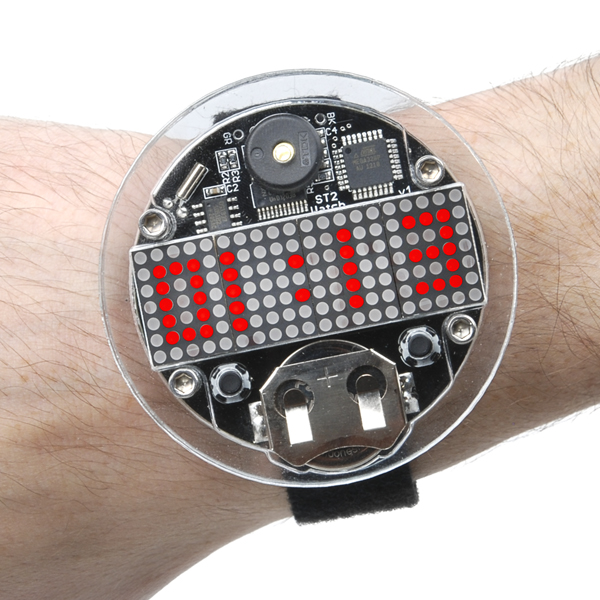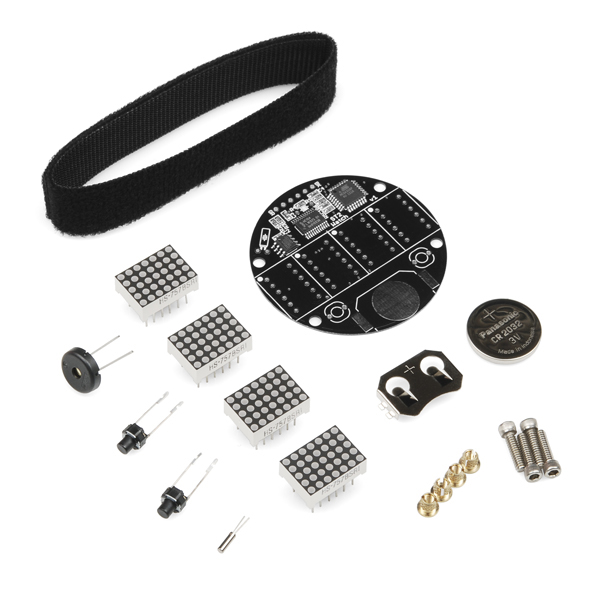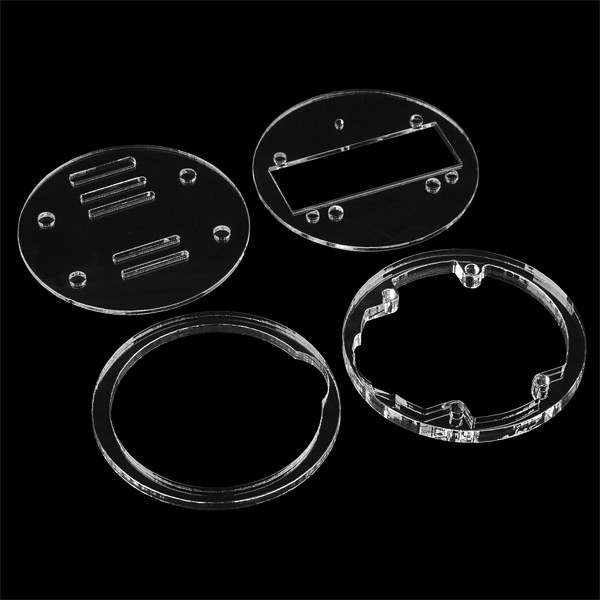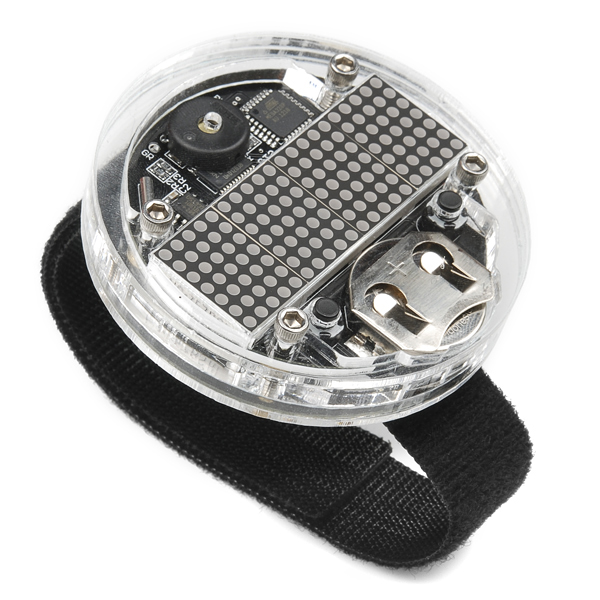Solder : Time II Watch Kit
The Solder : Time II is the latest version of Spikenzie Labs' Solder:Time watch kit. This new version is even more hackable than ever. The onboard microcontroller in this model is the very popular ATmega328P used in many of the current versions of Arduino. In fact, you can reprogram your watch using the same Arduino IDE software that you use for a regular Arduino!
The Solder:Time II is different from the original Solder:Time in many ways. The display has been upgraded to a set of four 5x7 LED matrix modules. This gives you control of a 7x20 matrix for a total of 140 LEDs! The new LED matrix allows for an amazing amount of information to be displayed; aside from the current time... The date, month, words, scrolling messages, graphics, special characters ... the possibilities are endless. It also comes with a piezo buzzer for the alarm function, but you can use it to add sounds to your custom programming and games.
Much like the original Solder:Time, the Solder:Time II comes to you as a PTH kit. There are SMD parts already soldered to the board when you get it, so don't worry about trying to solder those tiny lead-spacings. The body of the watch is still a "stacked acrylic" construction, but some changes have been made to make the watch sturdier and easier to assemble.
Note: Due to the requirements of shipping the battery in this kit, orders may take longer to process and therefore do not qualify for same-day shipping. Additionally, these batteries can not be shipped via Ground or Economy methods to Alaska or Hawaii. Sorry for any inconvenience this may cause.
- Based on the ATMega328P and programmable using the Arduino IDE
- 7x20 LED Matrix Give you control over a total of 140 LEDs
- Great PTH Soldering Kit for beginners
- FTDI Header for Easy Programming/Hacking
Solder : Time II Watch Kit Product Help and Resources
Core Skill: Soldering
This skill defines how difficult the soldering is on a particular product. It might be a couple simple solder joints, or require special reflow tools.
Skill Level: Competent - You will encounter surface mount components and basic SMD soldering techniques are required.
See all skill levels
Core Skill: DIY
Whether it's for assembling a kit, hacking an enclosure, or creating your own parts; the DIY skill is all about knowing how to use tools and the techniques associated with them.
Skill Level: Noob - Basic assembly is required. You may need to provide your own basic tools like a screwdriver, hammer or scissors. Power tools or custom parts are not required. Instructions will be included and easy to follow. Sewing may be required, but only with included patterns.
See all skill levels
Core Skill: Electrical Prototyping
If it requires power, you need to know how much, what all the pins do, and how to hook it up. You may need to reference datasheets, schematics, and know the ins and outs of electronics.
Skill Level: Rookie - You may be required to know a bit more about the component, such as orientation, or how to hook it up, in addition to power requirements. You will need to understand polarized components.
See all skill levels
Comments
Looking for answers to technical questions?
We welcome your comments and suggestions below. However, if you are looking for solutions to technical questions please see our Technical Assistance page.
Customer Reviews
4 out of 5
Based on 3 ratings:
1 of 1 found this helpful:
slightly disappointed
I bought it as a gift. Therefore, I was expecting a slightly nicer package. Instead, received a plastic baggie with no instructions or packaging whatsoever. As I wanted to give it to someone who hasn't heard of your product, I had to dig information on your website myself, look up instructions on how to assemble (which are not even available in nice downloadable form, by the way) and print it myself. Please consider that your product is promoted on many sources as cool gift idea, so maybe try to make it more gift-friendly. He hasn't assembled it yet so can't comment on product quality yet.
This watch is super cool
I have probably a hundred watches, and this one is a favorite. Lots of nice comments from people I meet.
Fun kit, decent instructions, lame strap
I enjoyed putting this kit together, it worked the first time and was a simple, fun project.
The instructions are pretty good, fairly clear and in color. There aren't any major discrepancies or spots where things weren't clear.
The wrist strap is pretty lame, it's why I don't currently bother wearing this thing, and I'm thinking about ways to make a better strap out of leather.





Too bad you guys don't sell those little LED Matrixes that are perfectly sized for letters...
What is battery life, assuming you don't have the LED on all the time?
Its works better with a lithum accu, like LIR2032 or PD2048. The Voltage is more high - 3.6V and not 2.95V.
I picked up one of these kits at Maker Faire in New York this last weekend. This one went together a lot easier than the Big Time kit that I built earlier. They've fixed the few problems I was having with the first version. I'm very pleased.
Does the piezo buzzer on this allow me to play tunes, or just output a single tone?
The firmware seems to imply that you can play tunes; beepsound(int freq, int freqlenght)
In the firmware it's used to give different beep tones when adjusting a value up vs down.
The image that shows the time (with the LEDs lit up) is photoshoped, isn't it?
I'd say yes, but I think it's because the display wouldn't photograph well.
a tiny watch-sized 7x20 led matrix with a DS1337s rtc. Sweet creator of the internet this is amazing!
this looks like the perfect entry for anybody that wants to program their own graphical watch. i can definitly see myself getting one of these someday.
after I already bought the original BigTime and hacked it to have the time, day of week, date, temperature, and battery voltage and text animations.... (i downloaded the original code and modified it heavily) http://www.youtube.com/watch?v=zYx6aEu1QAs
damn, this would have been perfect.
Hi, your code in the BigTime is amazing. Any chance to get the hex file or maybe even the code? Thank you anyway for the nice video and the ideas. Best Regards gerardf at web dot de
Schematic? List of components?
I want to write my own firmware for a watch, and this hardware looks like what I want, but without the schematic or at least the list of what's in there, I wouldn't buy it.
Please fix
To answer my own question, and in case anyone else is curious:
ATmega328P-AU is the micro, 74HC154 is used to help address the matrix, and DS1337S keeps time
Schematic link: http://www.spikenzielabs.com/Downloadables/ST2Schematic.pdf
Hi,
I am looking for a watch band to monitor accelerometer/gryoscope data. My prototype currently employs a proMini, 6DOF and Xbee.
Is there room for one of your 6DOF breakout boards and/or Xbee?
Is the i2c available on the board in this kit from the 328P?
If not, can I purchase the watch enclosure separately?
thanks, Richard